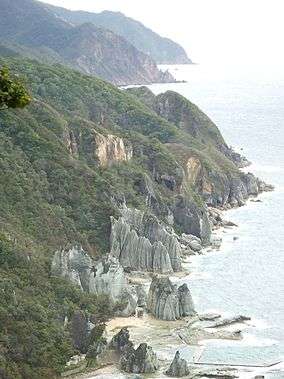Sai, Aomori
| Sai 佐井村 | |||
|---|---|---|---|
| Village | |||
 Hotokegaura coastline | |||
| |||
 Location of Sai in Aomori Prefecture | |||
 Sai | |||
| Coordinates: 41°25′46.8″N 140°51′32.8″E / 41.429667°N 140.859111°ECoordinates: 41°25′46.8″N 140°51′32.8″E / 41.429667°N 140.859111°E | |||
| Country | Japan | ||
| Region | Tōhoku | ||
| Prefecture | Aomori | ||
| District | Shimokita | ||
| Area | |||
| • Total | 135.04 km2 (52.14 sq mi) | ||
| Population (February 28, 2017) | |||
| • Total | 2,149 | ||
| • Density | 15.9/km2 (41/sq mi) | ||
| Time zone | UTC+9 (Japan Standard Time) | ||
| Symbols | |||
| • Tree | Hiba | ||
| • Flower | Lilium | ||
| • Bird | Osprey | ||
| Phone number | 0175-38-2111 | ||
| Address | 20 Nukamori, Sai-mura, Shimokita-gun, Aomori-ken 039-4711 | ||
| Website |
www | ||
Sai (佐井村 Sai-mura) is a village located in Aomori, Japan. As of 28 February 2017, the village had an estimated population of 2,149, and a population density of 15.9 persons per km2 in 978 households.[1] Its total area of the village is 135.04 square kilometres (52.14 sq mi).[2] In 2016, Sai was selected as one of The Most Beautiful Villages in Japan.[3]
Geography
Sai occupies the western coastline of Shimokita Peninsula, facing the inlet to Mutsu Bay from the Tsugaru Strait. The village has a cold oceanic climate characterized by cool short summers and long cold winters with heavy snowfall and strong winds (Köppen climate classification Cfb). The average annual temperature in Sai is 8.9 °C. The average annual rainfall is 1258 mm with September as the wettest month. The temperatures are highest on average in August, at around 21.8 °C, and lowest in January, at around -2.7 °C.[4] Much of the village is within the limits of the Shimokita Hantō Quasi-National Park. The mountainous area is home to many indigenous plant and animal species. Wildlife includes Japanese macaque monkeys, kamoshika, tanuki and Asian black bears. Approximately 90% of the village area is forested; of which 90% is national forest.
Neighbouring municipalities
Demographics
Per Japanese census data,[5] the population of Sai has declined over the past 40 years.
| Census Year | Population |
|---|---|
| 1970 | 4,622 |
| 1980 | 4,174 |
| 1990 | 3,348 |
| 2000 | 3,010 |
| 2010 | 2,422 |
History
The area around Sai was inhabited by the Emishi people until the historical period. During the Edo period, it was controlled by the Nambu clan of Morioka Domain and prospered due to its timber industry and as a ferry terminal to Ezo. During the post-Meiji restoration cadastral reform of 1 April 1889, Sai Village was proclaimed from the merger of Sai hamlet with neighboring Chōgō hamlet.
Economy
The economy of Sai is heavily dependent on forestry and commercial fishing. Approximately 90% of the village area is covered by mountains and forest, of which approximately 90% is national forest. Some of the locally caught seafood include sea urchin roe, sea pineapple, sea cucumber, scallops, abalone, konbu and squid. Seasonal tourism is also an important contributor to the local economy.
Education
Sai has one public elementary school, one public middle school and two combined public elementary/middle schools operated by the village government. The village does not have a high school.
Transportation
Railway
- The village has no passenger railway service.
Highway
Local attractions
- Hotokegaura, a series of naturally-carved cliff rock formations
- Shimokita Hanto Quasi-National Park
- Tsugaru Straits Cultural Museum Arusas
- Yanonemori Hachiman-gu
Local events
- February, Fukuura hamlet stages a kabuki show featuring northern styles of kabuki.
- June: sea urchin roe festival
- July: Hotokegaura festival
- August: Sai Summer Festival and fireworks
- September, Yanonemori Hachiman-gu Matsuri with floats pulled by the locals, during which Kagura is performed and Shinto priests bless the village houses
- November, Sai Culture Festival, during which different variations of festival songs and kagura are performed at the community centre.
- December: Winter illumination
Noted people from Sai
- Gōtarō Mikami – physician and Japanese Red Cross supporter during the Russo-Japanese War
References
- ↑ Sai official home page
- ↑ "詳細データ 青森県佐井村". 市町村の姿 グラフと統計でみる農林水産業 (in Japanese). Ministry of Agriculture, Forestry and Fisheries. 2016. Retrieved 13 July 2017.
- ↑ 公式サイト > お知らせ > 新たに4つの町村・地域の正式加盟が承認されました
- ↑ Sai climate data
- ↑ Sai population statistics
External links
![]()
- Official Website (in Japanese)
- Sai Tourism Website (in Japanese)

